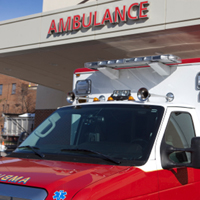Head of the Division of Emergency Medical Services and Disaster Medicine at Cooper
 It can be very stressful when an emergency medical event occurs that requires activation of the 9-1-1 system. It is even more stressful when you don’t know what to expect once that phone call is made. Understanding how 9-1-1 works, and what you need to do during and after that phone call, can go a long way in lessening the tension of an already stressful situation.
It can be very stressful when an emergency medical event occurs that requires activation of the 9-1-1 system. It is even more stressful when you don’t know what to expect once that phone call is made. Understanding how 9-1-1 works, and what you need to do during and after that phone call, can go a long way in lessening the tension of an already stressful situation.
How 9-1-1 Works
All 9-1-1 calls are answered by trained emergency medical dispatchers who will ask a series of questions based on the reason for the call. The dispatchers will have access to state-approved guidecards that will guide the dispatcher through the call to obtain specific information and to provide basic instructions to the caller. While on the call, the dispatcher will deploy emergency medical personnel to the scene.
The New Jersey Emergency Medical Services system, called EMS, provides two levels of response depending on the call. The first level: Basic Life Support (BLS) services, which are performed by certified Emergency Medical Technicians, or EMTs, who generally are responsible for ground transport via ambulances. The second level: Advanced Life Support (ALS) services, whose providers are certified paramedics or licensed Mobile Intensive Care Registered Nurses who are dispatched to potentially life-threatening incidents to offer the highest level of pre-hospital care.
What to Do When You Call 9-1-1
Please follow these recommendations:
1. Provide accurate information to the 9-1-1 dispatcher.
The dispatcher will send an ambulance with EMTs to provide BLS services and to transport the patient to the hospital. Based on the information received, the dispatcher will determine whether ALS services are needed. ALS services can later be requested or recalled by the EMTs after their assessment of the situation, but immediate accurate information can assist the dispatcher in getting the appropriate resources to the patient as soon as possible.
2. Be involved in the pre-hospital care.
Although sometimes difficult in emergency situations, patients should always understand the care that is being provided. EMS providers are patient advocates, and patients should work collaboratively with them for optimal care. Patients need to ask questions and to express any concerns to the EMS providers. Patients also should have available pertinent information that may affect their care (e.g., names of treating physicians and hospital affiliations, medications/medication list, advance directives, medical records, lab results, radiology reports). EMS providers will take the patient to the closest, most appropriate facility unless patients request transport to a particular hospital. Reasons to transport to a particular hospital include previous hospitalizations there, physician affiliations, and specialty care. However, EMS providers may not transport based on patient preference if the decision may negatively affect the patient’s health.
3. Trust in the EMS providers’ ability to provide care.
Both ALS and BLS providers are specifically trained to provide emergency care outside of the hospital setting. They must go through an initial certification and routine recertification processes approved by the New Jersey Office of Emergency Medical Services to function as EMS providers. These processes involve required and elective classes in various topics that are encountered in the pre-hospital setting.
For more information, contact your local EMS agency or access the New Jersey Office of Emergency Medical Services website at www.state.nj.us/health/ems.
